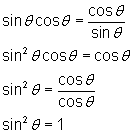Counterexample
Remember: to show an identity is true, you have to prove it for all values of a variable. In order to prove that an expression is false, you only need to show one value of the variable that doesn’t work. This is called a counterexample.
Sometimes you have trigonometric equations that are true for some values, but not for others.
When you provide a counterexample, you are looking for a value which results in an inequality instead of an equality.
Example:
Provide a counterexample that proves the equation  is not a trigonometric identity.
is not a trigonometric identity.
Procedure:
1. Simplify each side as much as possible using trigonometric identities where possible.
2. Find a value that can be substituted into the equation that makes it an inequality.
Solution:

Find a value for θ so  .
.
If 